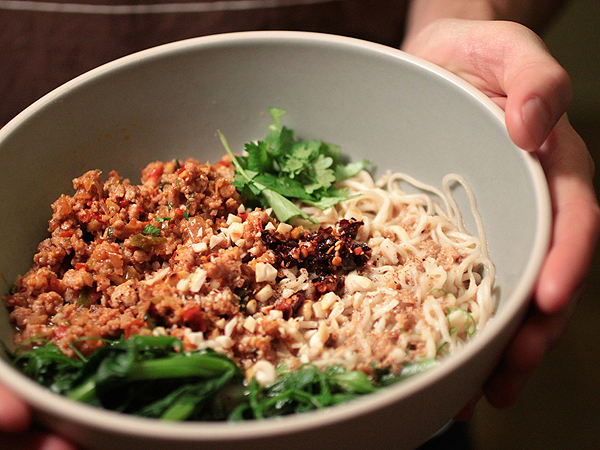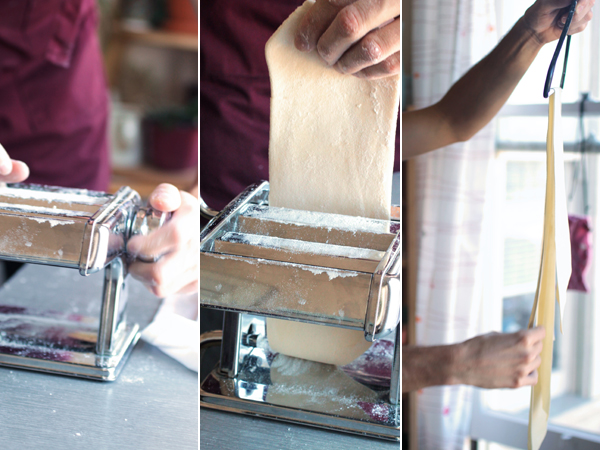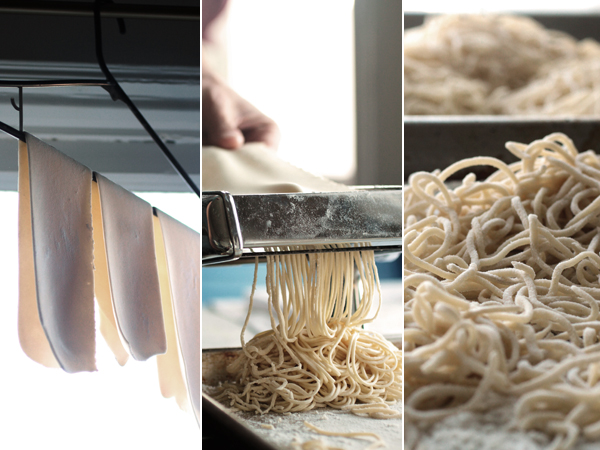
Boy, you guys are really something – thanks to you, we made the cut in Round 3 of Project Food Blog! This is my entry for challenge #4: photograph step-by-step instructions for a technique or recipe.
About a year ago, during dim sum with my parents, I wondered aloud whether I can make char siu bao (BBQ pork buns) at home. My mom’s ears perked up and that afternoon, she was digging into a closet, rummaging through boxes, emerging triumphant with a thin piece of paper. She handed me the paper, which had, printed in faded ink, a recipe in Chinese for char siu bao. Coming from a woman who never uses recipes, I knew this was a very, very big deal. Reading through, I saw that it not only unabashedly listed lard as a major ingredient, but also used old-timey Chinese measurements. Oh dear. It had me at catty.
You can imagine my excitement, then, when, as I was swooning over a particularly fabulous bowl of dan dan mein a couple months ago, she told me she would send me a recipe. For the next few days, I checked my email even more compulsively than usual and nearly jumped out of my chair when her message arrived. I opened the email, which contained one simple link – a link to PF Chang’s Dan Dan Noodles recipe.

Now, I don’t exactly have a problem with PF Chang. Ok, that’s a lie – let me rephrase. I don’t have a problem with it as long as we agree it’s not Chinese food. But here was my mom, my very own made-in-Hong-Kong mother, and she had just sent me a recipe from PF Chang. Well, let’s just say it’s a rather… interesting… turn of events. Then again, she had sat patiently at her computer to find and send me that link, undeterred by her modem-speed connection. Isn’t it the least I can do to actually make some noodles?
Which is why the other night, I sat down on the couch and opened up my laptop. In the hopes of soliciting a few non-PF-Chang-sponsored perspectives, I typed “dan dan noodles” into Google. And fell, head-first, down the rabbit hole.
 |
 |
Dan dan mein, you see, originated as a street food in the Szechuan province and simply translates to “Peddler’s Noodles”, with dan signifying the pole the street vendors used to carry their baskets and stoves. But from there, the history gets unbelievably complicated and confusing.
As far as I can tell, there are at least five major classes of this noodle dish, spanning four different countries. Those closer to the original Szechuan version are made by piling warm noodles over a pool of chili oil and topping with minced meat and preserved vegetables. More modern versions add sesame paste to the sauce, but whether this modification came from Taiwan is up for debate. In Japan, dan dan mein became tantanmen and looks remarkably like ramen, with the spice kick significantly toned down. Meanwhile, this side of the Pacific, they remain a drier, tossed form of noodle dish but have evolved to be sweeter/less spicy due to omission of Szechuan peppercorns and frequent addition of peanut butter. Sometimes, they’re even served cold.

Perhaps most interesting of all, though, are the versions found in Hong Kong and Shanghai that seem to have taken bits and pieces from all those other adaptations. There, when you order dan dan mein, you get spicy noodles topped with minced meat, sitting in a rich broth streaked with sesame-peanut paste. This last version sounds most like what I was swooning over and naturally became the starting point to my own attempt. Along the way, of course, I couldn’t help but throw in a few changes of my own – a splash of black vinegar, a sprinkle of ground Szechuan peppercorns, a bundle of blanched pea shoots, a dollop of chili oil – all inspired by the other members of the big happy dan dan mein family.
You know, maybe my mom was trying to tell me something after all. In the end, what really matters isn’t whether a recipe is Chinese, Taiwanese, PF-Changinese, or some mixed-up jumble of all of the above. The true test of any recipe is whether what you end up with satisfies your stomach and soothes your soul. These noodles? They pass with flying colors.
—-
You can make dan dan mein with most types of Asian noodles you find at the store, either fresh or dried: Chinese wheat noodles (with egg or without), Japanese udon, Korean noodles, rice noodles, etc. Even spaghetti or linguine can work in a pinch. But if you do have some time, perhaps on a weekend day, making your own noodles can transform the dish from just delicious to absolutely sublime. And if, like me, you have the helping hands of your husband, sister, and friends, making noodles can even be a social affair.

To make Chinese-style eggless noodles, start with the dough. Mix together 2 cups of flour and ½ tsp of salt. Slowly incorporate water (about ½ cup) until the dough comes together.

Knead until smooth and slightly stiff. Wrap in plastic and let rest for at least 30 min.

Cut off a small piece of dough and flatten into a rough rectangle with your fingers. Fold in thirds and pass through the thickest setting of your pasta roller. Do this about 5-6 times, dusting with flour as often as needed to keep dough from sticking.

Thin out the sheet by decreasing the pasta roller setting one notch at a time. Stop at either the 3rd or 4th setting depending on your preferred noodle thickness.

Dust the sheet with flour and hang to dry for about 15-20 min. Repeat with the rest of the dough. Cut each sheet into noodles using the pasta roller’s cutter slot. Toss with flour and lay on baking sheet to dry a bit before cooking.
This makes about 2-3 servings of noodles. To make more, I suggest making a second batch of dough instead of scaling up because a larger amount of flour becomes harder to knead and work with.
Adapted from this Chinese recipe. You can find dou ban jiang and Chinese sesame paste at Asian supermarkets.
From a reader’s comments, it seems that saltiness of dou ban jiang seems to vary by brand, so start with 3 Tbsp of the paste and taste the meat topping to see if you like that level of salt. Add more according to your taste. I generally prefer things on the salty side and I use Lee Kum Kee brand of dou ban jiang, so I ended up using about 5 Tbsp of dou ban jiang.









27 Comments
Beautiful tutorial! Homemade noodles always feel really special (on top of tasting great). Gorgoeus photos. nicely done. I voted for you!
Good luck! Hope to see us both in round 5! =)
Thanks Jacob! It’s true – making noodles at home will make any day special. :)
I am learning so much with these posts…Thanks a lot for YOUR lesson!!
I’m learning so much too and I’m loving it! Thanks for visiting!
I am a noodle lover from way back, so you already won me over with the subject line. Your tutorial has strong photos—very well done.
This is my first visit to your blog—don’t know how I missed you! If this post is representative of what you have here, I am in for a treat.
Don’t worry, Debi, I missed like 50 great blogs in the first few rounds too – there were just too many good ones and too little time. Thanks for visiting now! Noodles lovers unite! :)
AWESOME post! I feel like I fell down the rabbit hole too while I was reading this informative post! I cant get enough of background info about food, so this was so interesting to me. And your photos were also amazing, I would say a perfect entry for this challenge. :) Voted, and good luck!!
Thanks Amanda! I hope you’re safely back out of the rabbit hole now! :)
Gorgeous! I loved that you made your own noodles. My stomach just growled :D The only way it woulda been better is if you had actually used lard lol, Cheers! Just voted…
Oh good idea – why didn’t I think of adding a scoop of lard to the whole thing? ;) Thanks so much for your vote!
I totally agree with your philosophy. We sometimes miss out on some good, flavorful food when we deem it not authentic enough. Liked the flow of your post and the step-by-step – that shower of noodles from the pasta machine makes me want to buy one right now (machine, not noodles). My vote’s in. Good luck!
Heena, you should definitely buy a pasta machine and I promise I don’t work for a pasta machine company! Making noodles is really fun and there’s something so calming about rolling out the dough. :) Thanks so much for your vote!
Goodness gracious! The photos of the noodle making process are out of this world amazing! WOW WOW WOW! Very impressive and delicious too! This dish is right up my alley – will most definitely try making this as well, but not sure I can bust out my own noodles (certainly not ones that would taste good). You’ve got my vote. Also, like the reference to PF changinese….that is hilarious.
Patty, I promise you can absolutely make your own noodles and they will taste awesome. I actually was really scared about making noodles just with flour and water, but in the end, they turn out to be a lot easier to work with than I thought. And it’s kind of amazing to think that those noodles came from nothing more than two (well, three when you count the salt) ingredients.Thanks so much for reading and voting!
What a fun project! And a great tutorial and pictures nonetheless! Good luck in round 4!
Thanks so much!
Now I wish I had gotten that pasta machine! This is delicious! Thanks for sharing the recipe, i hope I can make this one soon :)
Get the pasta machine, Alisa! You won’t regret it, I promise. :) But even before you get it, you should give this recipe a try with store-bought noodles, which is what I plan to do when I don’t have time to make my own noodles. Thanks so much for reading!
Been looking for over a year for “din din” per the Number One Noodle Shop in Paris. Known around the the world as a cure for the NY to Paris jet lag. Sweats out all that poison! Thanks!
Ooo this would definitely be excellent jet-lag food indeed – brilliant! Thanks for reading!
I’m thinking that 5 Tbsp of dou ban jiang (chili bean paste) was too much, a massive amount of salt. Next time I will try
3 tbsp of the bean paste and 2 of Sriracha. I made it last week, closed my eyes and I was back in Paris at the Number One Noodle Shop!!!
Thanks a million and Happy New Year
Oh I like the idea of mixing in Sriracha! I do tend to make things on the salty side, so perhaps I did go a little overboard with the dou ban jiang. Also, I wonder if it depends on what brand of dou ban jiang we use? I mostly use the Lee Kum Kee brand of sauces.
The one in the cute shaped jar….Sichuan Gao Fu Ji Food Co. I’m making it tomorrow nite for guests, and one does not like picante food! Sorry, it’s 3 to one on that vote!
Wish me luck……..
Fun! I hope your dinner party turned out fabulous, Noodle and maybe you converted your anti-spicy-food friend over to a spicier (and more delicious) lifestyle? I’ve never tried that brand of dou ban jiang but it’s very likely the salt level is different in the brand I use. I’m glad you’re able to adjust the amounts to make a dish you enjoy – that’s what truly matters! :)
The Dan Dan was a great success, I just put less of the meat mix in the persons that was not into hot. He loved it.
And I found pea shoots at the International Market……..what a great taste, like a jazzed up spinach.
All the years of growing peas and we fed the vines to the cows….who knew?
Thanks for the great “receipt”…… Noodle
So happy you liked the recipe, Noodle, and that your dinner party was a success! :)
Been almost a year! Cold weather and Dan Dan!!!….. this time I had to substitute everything…lol I read that every street vendor in China made it a different way, so did I. I think as long as you have noodles, pork, and Szechuan pepper…you have it made. It turned out great. But oatmeal WITH bacon and eggs….. madness!!!
2 Trackbacks
[…] cross referenced this recipe online with my Celia Chang cookbook and created a yummy dish. I totally forgot to include black vinegar, […]
[…] http://www.riceandwheat.com/2010/10/dan-dan-mein-street-peddlers-noodles/ […]